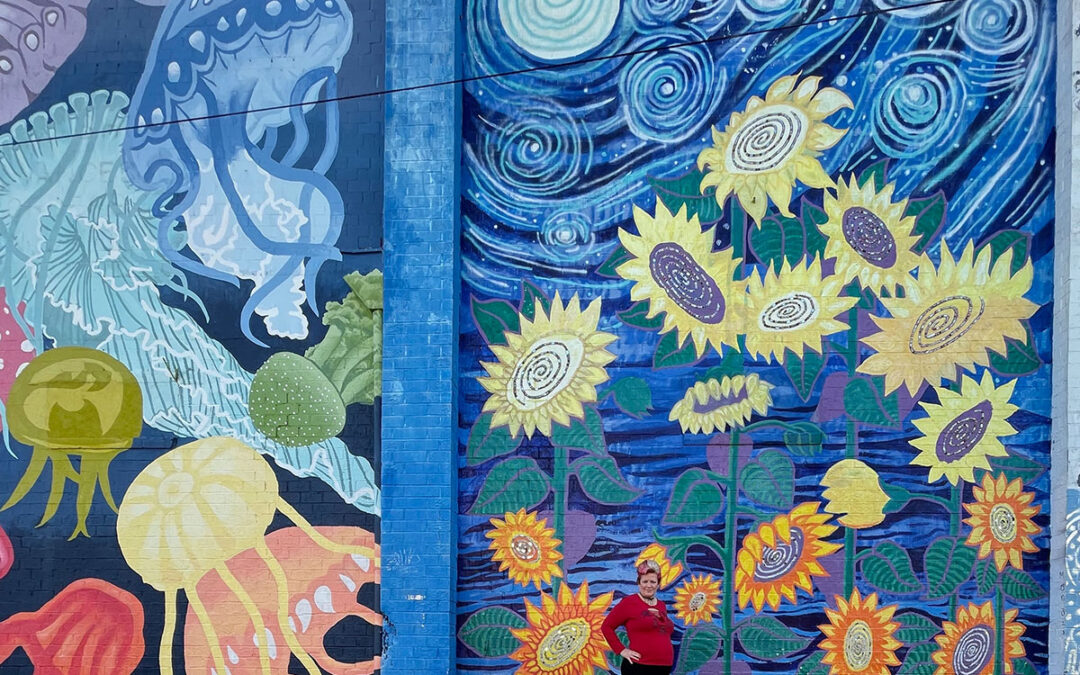#savemurrayhillmurals #savethesunflowersmural
Murray Hill has lost three of the ten murals that were painted five years ago as a neighborhood beautification project by the Murray Hill Preservation Association while artist Jason Tetlak was President. The Calvin and Hobs mural was on the bank building that was razed to build the Lofts Apartment complex. The 3D mural by Jason Tetlak was painted over with grey and the mural on the wall facing the PNC bank parking lot was recently painted over with white for unknown reasons. Next in line for removal are the Jellyfish mural and the Sunflower mural located on the alley side of the former J&W Discount near the corner of Edgewood Avenue and Post Street. You can see them from the Dreamette peaking over the taco place on the corner. Just put “sunflower mural” into Google maps and it will show up as a tourist destination with 5-star reviews. The Sunflower Mural has been a Pokemon Go stop for 4 years.
Sunflower mural artist Brenda Kato is asking for ideas on ways to help quantify the value the Murray Hill murals have provided to the community. The original J&W Discounts building owner Michael Danhour paid for the paint and lift, Brenda supplied the design and the community helped provide the labor. Brenda has asked MHPA to help her show the value of the murals to the area to the church leaders and support the refresh project. Many areas of town are actively seeking mural artists to help increase the value of their property, why is Murray Hill starting to paint over their murals? It will be a shame if the new owners decide to cover up the murals.
What can we do?
Please help alert the community. Speak up now! Let folks know why you value the murals and how they have made the area more desirable. We urgently need the community to show support right now by telling the property owners, representatives, and the press why they value the murals before they are all removed.
Ways to take action, please reach out to:
- The mural property owners
- The District Church leadership (Jellyfish & Sunflower mural building)
- Your local and state representatives
- Google search for “Sunflower Mural Jacksonville” and leave a review on Google Maps
- Follow sunflower mural artist @brendakato
One way to persuade property owners not to paint over the Murray Hill Murals is to explain to them the importance of preserving public art. Murals reflect the history, culture, and values of our community and are a source of pride and joy for locals. Locals could explain to the property owners how much of an asset the murals are for the community, both economically and socially, and how they attract tourism and benefit local businesses. We could also emphasize how these murals are an investment in the future of the community, as they can be passed on to future generations. Finally, we could offer to work with the property owners to explore creative ways to preserve the murals, such as highlighting them with special lighting, restoring any faded colors, and sealing them with clear UV-protective coatings.
How do the Murray Hill Murals add value to the area?
Public murals provide a variety of benefits to the community. They serve to beautify the area, add color to a drab environment, and create a sense of community pride across generations. Additionally, the Murray Hill Murals bring people together, create a sense of connection, and help foster a sense of belonging. The Murray Hill murals benefit local businesses by increasing foot traffic, providing a unique backdrop for photographs, and promoting a sense of local pride. The murals benefit the local economy, as people are often more likely to visit and shop in areas that are aesthetically pleasing. Overall, the Murray Hill murals are powerful tools for uniting a community and helping it to thrive.
How do the Murray Hill Murals benefit the local economy?
The Murray Hill Murals benefit the local economy in a number of ways. For starters, they attract tourists to the area, which results in increased spending at local businesses. Additionally, they act as a source of pride and inspiration for the local community, which can help to create a sense of identity and belonging among residents. Furthermore, the murals act as a form of advertising for local businesses, allowing them to gain more recognition and potentially more customers. Finally, public murals can also act as a source of revenue for local artists, providing them with an opportunity to showcase their work and earn money from it. All of these factors add up to make a significant contribution to the local economy.
What is the average lifespan of a public mural?
The average lifespan of a public mural can vary greatly depending on the environment, materials used, and maintenance. Generally, public murals can last anywhere from 5 to 25 years, with the average being around 10-15 years. Good maintenance and protective coatings can help extend the life of a mural.

